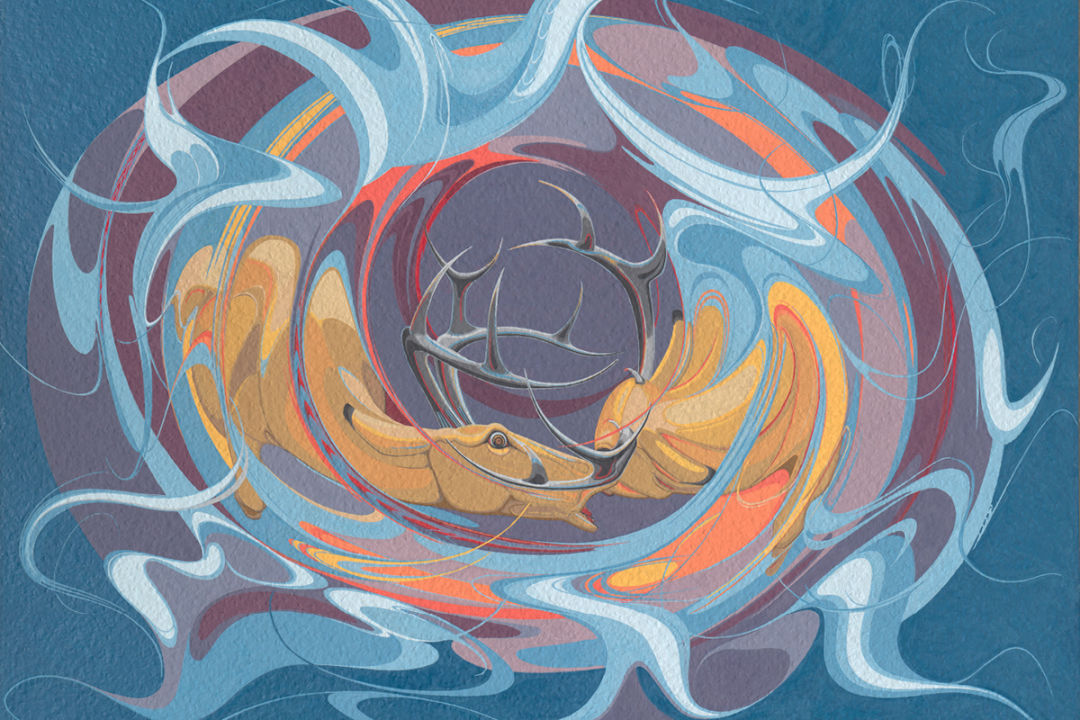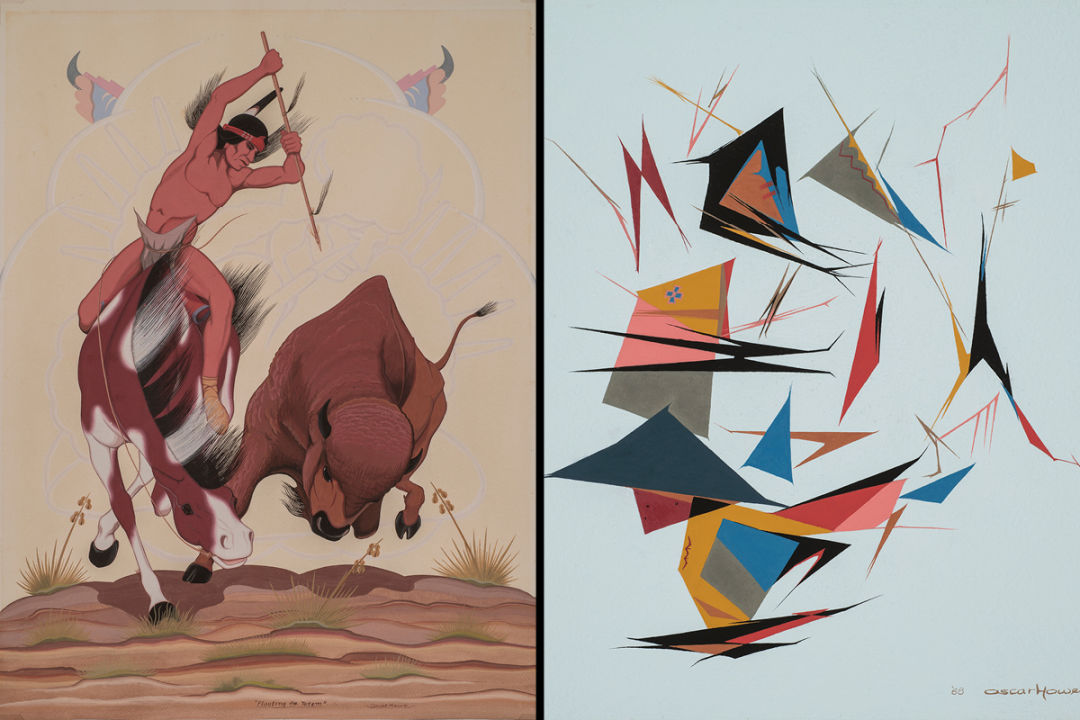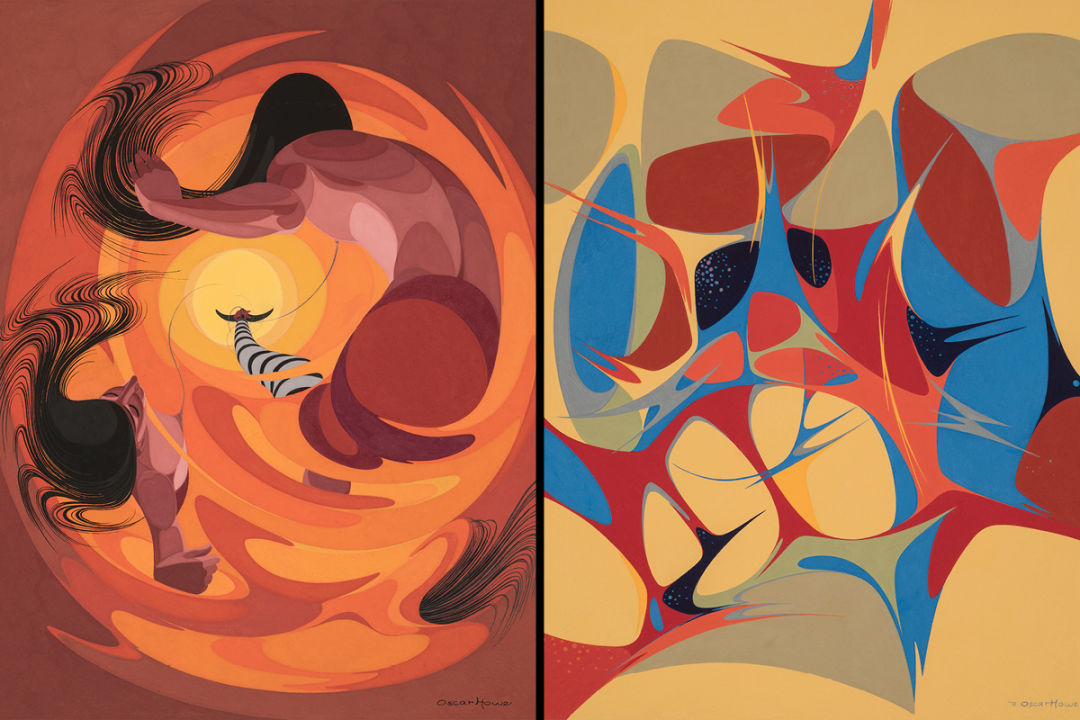New Exhibition Gives Influential Native American Artist Oscar Howe Long Overdue Recognition

Oscar Howe (Yanktonai Dakota, 1915–1983), Fighting Bucks, 1967. Casein on paper, 20 1/4 x 26 15/16 in. National Museum of the American Indian 27/0217
This month the Portland Art Museum opens an exhibition featuring work by an artist that many will likely have not heard of before. Dakota Modern: The Art of Oscar Howe, which comes to Portland after premiering at the Smithsonian National Museum of the American Indian, celebrates his work and legacy. The exhibition is on view October 29, 2022 - May 14, 2023, and is being shown alongside an expansive site-specific installation by Jeffery Gibson called They Come From Fire. Read on to learn more from exhibition creator and Portland Art Museum Curator of Native American Art, Kathleen Ash-Milby.
When the Dakota artist Oscar Howe passed away in 1983, he had become a legend among Native artists as much for his paintings as his bold strike against the gatekeepers of Native American art in the mid-20th century. A student of both Dakota artistic traditions and modernism, he created artwork steeped in cultural knowledge but expressed in a distinctly dynamic approach.

Oscar Howe (Yanktonai Dakota, 1915–1983), Flouting the Totem, 1949. Casein on paper, 28 1/2 x 22 in. Private Collection of Sharon Pennington and her daughter Shannon (Left)
Oscar Howe (Yanktonai Dakota, 1915–1983), War Dancer, 1968. Casein on paper, 19 3/4 x 24 in. University Art Galleries, University of South Dakota, PC OH 45 (Right)
Despite what was arguably conventional subject matter, the vivid abstract forms and dynamic motion in Howe’s paintings were unsettling to some who were more comfortable with the tranquil and nostalgic approach to Native American painting that had been largely established in the early 20th century. After one of Howe’s paintings was rejected from competition by the jurors for the Philbrook Museum of Art’s annual Indian painting exhibition in 1958, he fired off a passionate letter to the museum including the withering words, “Who ever said that my paintings are not in the traditional Indian style has poor knowledge of Indian art indeed.”
While Oscar Howe’s stature as the “grandfather” of contemporary Native American art has lived on, he was never recognized widely for his achievements and, until Dakota Modern: The Art of Oscar Howe debuted in New York this past spring, was all but unknown in the larger art world. This exhibition seeks to secure his legacy as an important mid-century artist and American modernist, expanding the recognition of modernism beyond the elite circle of artists recognized in the canons of American art and global modernism. While newcomers to Howe’s work will be immediately taken with his expressive yet fastidiously detailed paintings—which New Yorker art critic Peter Schjeldahl described as “power-packed compositions” with “aggressive hues” and the “channeling of sheer, visionary imagination”—the exhibition will also give viewers insight into his development and tools for understanding the content of his work.

Oscar Howe (Yanktonai Dakota, 1915–1983), Sacro-Wi-Dance (Sun Dance), 1965. Casein on paper, 28 x 22 1/2 in. University Art Galleries, University of South Dakota, PC OH 29 (OH 99.1) (Left)
Oscar Howe (Yanktonai Dakota, 1915–1983), Abstraction after Wakapana, 1973. Casein on paper, 24 7/8 x 20 3/16 in. Oscar Howe Family Collection, University Art Galleries, University of South Dakota, HF OH 1 (Right)
After an initial introduction to some of Howe’s most dynamic compositions, viewers will begin the exhibition with his earliest student work from the 1930s. His development rapidly advanced between these early years and his work in the 1940s and 1950s, as his approach was informed by experiences as a Works Progress Administration (WPA) artist and his art degrees earned at Dakota Wesleyan and the University of Oklahoma. As the viewer moves through the exhibition which focuses largely on his mature work in the late 1950s and 1960s, they will learn about the content of Howe’s work as a storyteller who depicted Dakota and Lakota creation stories, cultural figures, and practices, as well as his technique and masterful use of line and color. The exhibition concludes with a gallery film focused on his biography, including his connection to popular culture through his decades-long work as a mural designer for the “Corn Palace” in Mitchell, South Dakota, and his appearance on the television show This Is Your Life, hosted by actor Vincent Price.
We hope our audiences here in Portland will find Oscar Howe’s work both beautiful and inspiring, leaving the exhibition with a deeper appreciation for this American master whose legacy of innovation and advocacy will continue to inspire generations.
Kathleen Ash-Milby,
Portland Art Museum Curator of Native American Art
VISIT
Hours
- Wednesday through Sunday, 10 a.m. to 5 p.m.
Tickets
- Free for youth 17 and under. $25 for adults; $22 for college students and seniors;
Free and lower costs ways to visit
- Free admission for youth aged 17 and under
- Free admission for veterans
- Community free day—September 17
- $5 admission for Oregon Trail Card holders
- $25 yearly College Student Pass
- Multnomah County Library Discovery Pass
- Exhibition lead sponsor Bank of America offers cardholders free PAM admission on the first full weekend of each month through the Museums on Us
